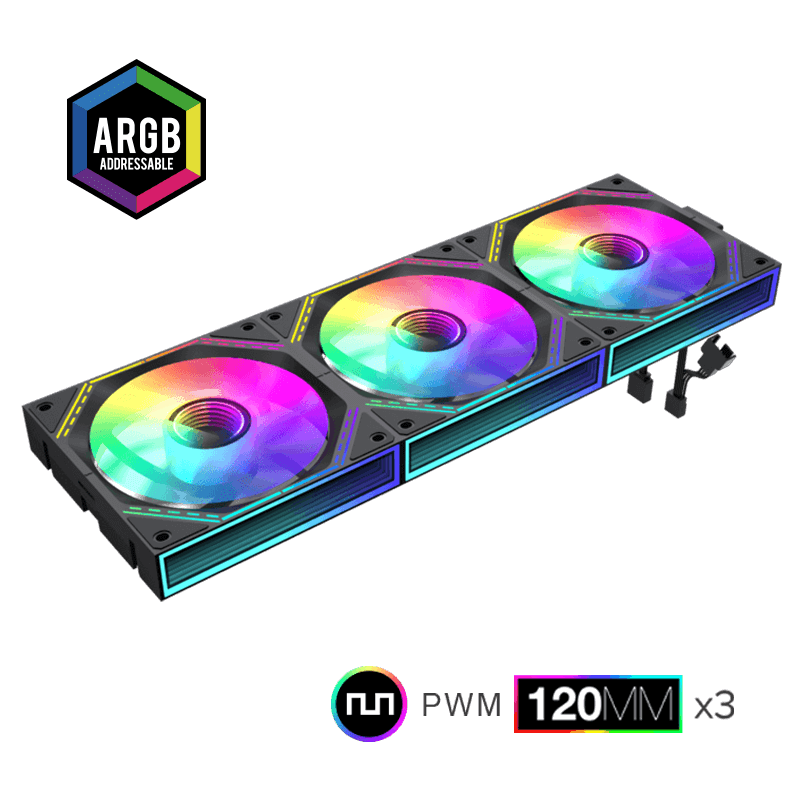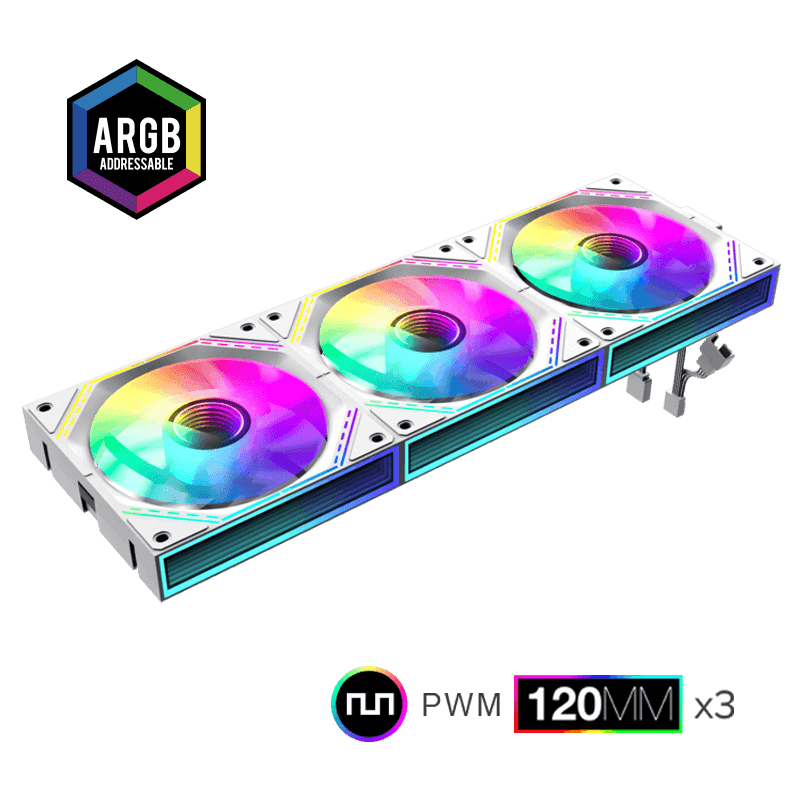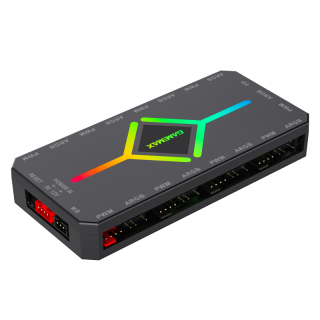In the high - performance world of PC gaming and intensive computing, maintaining optimal temperatures is crucial. This is where PC case fan controls come into play, acting as the command center for your PC's cooling system.
PC components, especially the CPU and GPU, generate a significant amount of heat during operation. Without proper cooling, high temperatures can lead to thermal throttling, where the components reduce their performance to avoid overheating. Fan controls allow you to adjust the speed of your case fans according to the temperature of your components. For example, when you're engaged in a graphically - intensive game that causes your GPU to heat up, you can increase the fan speed to ensure efficient heat dissipation. This not only prevents performance degradation but also extends the lifespan of your components.

Fans running at full speed can be quite noisy, which can be a distraction, especially in a quiet environment. Fan controls give you the flexibility to reduce fan speed when your PC is under light load, such as when you're just browsing the web or working on a document. This way, you can enjoy a quieter computing experience without sacrificing too much on cooling performance.
Analog Fan Controllers: These are simple devices that usually come with knobs. They work by adjusting the voltage supplied to the fans. By turning the knob, you can increase or decrease the voltage, which in turn changes the fan speed. For instance, a lower voltage results in a slower fan speed, while a higher voltage makes the fan spin faster. However, analog fan controllers may not offer the most precise control, and they can sometimes cause voltage drops that affect the fan's performance.
Digital Fan Controllers: Digital fan controllers are more advanced. They often use Pulse - Width Modulation (PWM) technology. PWM works by sending a series of on - off pulses to the fan. The duty cycle (the proportion of time the pulse is on) determines the average voltage received by the fan, thus controlling its speed. Digital fan controllers can offer more accurate and precise control, and they can also be programmed to adjust fan speeds based on specific temperature thresholds.
BIOS Fan Control: The BIOS (Basic Input/Output System) of your motherboard provides a basic level of fan control. You can access the BIOS settings when your PC boots up. In the BIOS, you can set fan speed profiles, such as quiet mode (low fan speed for low - load situations), performance mode (high fan speed for high - load situations), or custom mode where you can define your own fan speed curves based on temperature. BIOS fan control is useful as it works independently of the operating system, but it may have a limited number of options compared to some software - based solutions.
Third - Party Software: There are many third - party software applications available that offer comprehensive fan control. For example, SpeedFan can monitor the temperature of various components in your PC and adjust the fan speeds accordingly. It provides a user - friendly interface where you can set up custom fan curves, and it also displays real - time temperature and fan speed readings. Other software like MSI Afterburner (for MSI graphics cards) and NZXT CAM (compatible with NZXT products and some other hardware) also offer advanced fan control features, along with additional functionality such as overclocking and system monitoring.
Fan splitters are the simplest form of fan control accessories. They allow you to connect multiple fans to a single fan header on your motherboard. While they don't directly control the fan speed, they are useful when you have more fans than available fan headers. For example, if your motherboard has only 3 system fan headers but you want to install 5 case fans, you can use fan splitters to connect the extra fans. However, keep in mind that all the fans connected to a splitter will run at the same speed determined by the motherboard's fan control settings for that particular header.
Fan hubs are more advanced than splitters. They typically connect to a SATA power cable for power and to a motherboard's USB or fan header for control. Fan hubs can support a larger number of fans, often up to 6 or more. Some fan hubs, like the Arctic Case Fan Hub, can distribute power evenly to all connected fans without voltage loss. They also allow for more organized cable management, as instead of having multiple fan cables directly connected to the motherboard, you can use a single cable from the hub to the motherboard. Additionally, some fan hubs support PWM control, enabling you to adjust the speed of each fan connected to the hub.
Some high - end PC cases come with built - in fan controllers. These controllers are usually located on the front panel of the case and may have buttons or knobs for adjusting fan speed. For example, the Corsair Crystal Series 570X case has a built - in fan controller that allows you to easily switch between different fan speed profiles. The advantage of integrated fan controllers is their convenience, as they are easily accessible on the case itself. However, the functionality of these built - in controllers may be limited compared to dedicated third - party fan controllers or software - based solutions.
Component Power Consumption: If you have a high - end CPU and GPU with high power consumption, you'll need a more robust fan control solution. For example, if you're using an overclocked Intel Core i9 CPU and a high - end NVIDIA RTX graphics card, you may want to invest in a digital fan controller or use powerful third - party software to ensure that your fans can keep up with the heat generated.
Case Design and Ventilation: The design of your PC case also affects your cooling needs. Cases with good ventilation, such as those with mesh front panels, may require less aggressive fan control as they allow for better natural airflow. On the other hand, cases with glass panels or limited ventilation may need more precise fan control to maintain proper temperatures.
Motherboard Compatibility: Ensure that the fan control device or software you choose is compatible with your motherboard. For example, some motherboard models may not support certain third - party software for fan control, or they may have limitations in terms of the number of fans that can be controlled through their fan headers.
Fan Compatibility: Different fans may have different requirements in terms of voltage and control signals. Make sure that the fans you have are compatible with the fan control method you select. For instance, some fans are designed specifically for PWM control, while others may work better with analog voltage - based control.
Fan controls range in price from inexpensive fan splitters that cost a few dollars to high - end digital fan controllers that can cost upwards of $50 or more. Determine your budget based on your needs and the level of control you require. If you're on a tight budget, fan splitters or using the BIOS fan control may be sufficient. However, if you're looking for advanced features and precise control, you may need to invest in a more expensive fan controller or software.
Mounting the Controller: If you're installing a fan controller in a drive bay of your PC case, first remove the appropriate drive bay cover. Then, slide the fan controller into the drive bay and secure it using the provided screws.
Connecting the Fans: Connect the fans to the fan controller according to the controller's instructions. For analog fan controllers, you'll typically connect the fan power cables to the controller's output terminals. For digital fan controllers with PWM support, make sure to connect the fans to the correct PWM - compatible ports.
Power and Control Connections: Connect the fan controller to a power source. For most fan controllers, this will involve connecting a SATA power cable. If the controller requires a connection to the motherboard for control (such as some digital fan controllers), connect the appropriate cable (e.g., a USB cable or a fan header cable) to the motherboard.
BIOS Fan Control Setup: When setting up BIOS fan control, restart your PC and press the appropriate key (usually Del, F2, or F10) to enter the BIOS setup. Navigate to the fan control section, which may be located under the "Advanced" or "Hardware Monitor" tab. Here, you can set up fan speed profiles or adjust the fan speed curves based on temperature.
Third - Party Software Setup: Download and install the third - party fan control software from the official website. Once installed, launch the software. The software will usually detect your PC's components and fans automatically. From there, you can set up custom fan speed profiles, adjust fan curves, and monitor temperatures in real - time.
Fan Speed Monitoring: Periodically check the fan speeds to ensure that they are operating as expected. This can be done through the BIOS, third - party software, or the built - in display on some fan controllers. If you notice that a fan is not spinning or is spinning at a much lower speed than it should, it may indicate a problem.
Temperature Monitoring: Keep an eye on the temperatures of your PC components. If you notice that the temperatures are higher than normal, it could be due to a problem with the fan control, such as a misconfigured fan curve or a malfunctioning fan.
Fan Not Spinning: If a fan is not spinning, first check the physical connections. Make sure that the fan is properly connected to the fan controller or the motherboard. If the connections are okay, try testing the fan on a different fan header or with a different power source. If the fan still doesn't spin, it may be defective and need to be replaced.
Incorrect Fan Speeds: If the fan speeds are not adjusting as expected, check the fan control settings. In the case of software - based control, make sure that the software is configured correctly and that there are no conflicts with other applications. For hardware - based fan controllers, check for any loose connections or damaged components. If you're using a BIOS fan control, ensure that the BIOS settings are correct and that the motherboard firmware is up - to - date.
In conclusion, PC case fan controls are an essential part of maintaining a cool and quiet PC. By understanding how they work, choosing the right type for your needs, and properly installing and maintaining them, you can ensure that your PC's components stay at optimal temperatures, providing you with reliable performance for years to come.

GameMax FN12A-S3I, 120mm Black frame ARGB Fan x3,120mm Computer case fan!
• Revolutionized daisy-chain ARGB fan.
• Infinity mirror look all around.
• 3 pcs 120mm full function ARGB PWM fans
• The intelligent temperature controls the speed at 800~1600±10% RPM, by linking to the motherboard PWM 4pin socket, so the fan speed auto controlled and keeps the fans quiet.
• Only one cable is required for a cluster of fans.
• Embedded magnetic Fluid Dynamic Bearing to provide stability, durability, and longevity.
• 26 LEDs in each fan,Center 8pcs, Outer ringg 18pcs.

GameMax FN12A-S3I-RW, Reverse 120mm White frame ARGB Fan x3,120mm Computer case fan!
• Revolutionized daisy-chain ARGB fan.
• Infinity mirror look all around.
• 3 pcs 120mm full function ARGB PWM fans
• The intelligent temperature controls the speed at 800~1600±10% RPM, by linking to the motherboard PWM 4pin socket, so the fan speed auto controlled and keeps the fans quiet.
• Only one cable is required for a cluster of fans.
• Embedded magnetic Fluid Dynamic Bearing to provide stability, durability, and longevity.
• 26 LEDs in each fan,Center 8pcs, Outer ringg 18pcs.
• 【Reverse Blade of Fan】 Reverse Fan Blade for Power Supply Shroud /Bottom plate of Case for Air Intakes, to additional increase airflow from bottom to vertical chassis design type.

V4.0 ARGB HUB PWM Black PWM |5V ARGB SYNC | REMOTE CONTROLMULTI-FEATURED HUB FOR GAMING CHASSIS
• MAGNETIC DESIGN FOR EASY INSTALLATION,The Magnet At The Bottom Of The Controller Can Be Firmly Attached To The Metal Plate Of The Chassis, Making Installation Easy!
• *Design Of Multi-channel PWM Temperature Control Interface
• Support SYNC With ASUS,MSI,GIGABYTE ASROCK..ETC MOTHBOARD WITH 5V3PIN ADDRESS RGB PORT
• Once Link to Motherboard, Leave the Application Software to Control Light Mode
• The Controller Can Be Connected To The Motherboard CPU Fan Interface To Access Temperature Control Information
• Remote control adjusts speed of fan and light mode, with memory record function